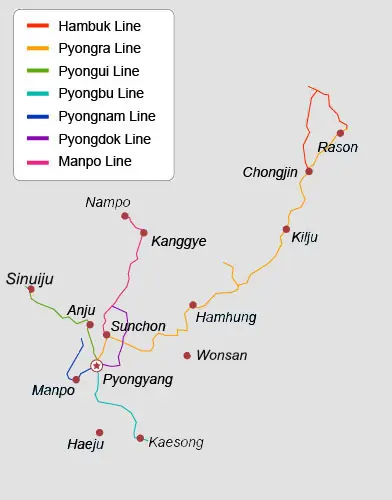
All the railway lines in North Korea are operated by the state-owned Korean State Railway. The railway system consisting of an extensive network of standard-gauge lines and a smaller network of 762 mm (30.0 in) narrow-gauge lines. The most important lines are in the northern part of the country. Following are some critical rail lines in North Korea.
Hambuk Line (함북선): Ch'ŏngjin Ch'ŏngnyŏn - Rajin
This line is one of the main trunk railways in North Korea, connecting Chongjin (the capital of North Hamgyong Province) and Rajin Station (Special city located in the northeastern border of China, Russia and North Korea).
The whole line is a single-track electrified railway with 50 stations. The length from Chongjin Station to Rajin Station is 331km (205miles). The major stations passed on the way include Hoeryŏng Ch'ŏngnyŏn (회령 청년). Different from the coastal P'yŏngra Line, this line passes through the Hamgyong Mountains, after Hoeryŏng, along the Tumen River and then exits the coast to reach Rajin Station and connects with P'yŏngra Line there.
Pyongra Line (평라선): P'yŏngyang - Rajin (and on to Khasan, Russia)
Connecting the capital Pyongyang and the eastern city of Rassin. The entire line is a 3,000 volt DC electrified single-track standard gauge railway with 130 stations. The length between Pyongyang Jianli Station and Rajin Station is 786km (488 miles). The main cities passed by on the way include Pyeongseong, Suncheon, Hamhung, Duancheon, Gimchee and Chongjin.
Pyongui Line (평의선): P'yŏngyang - Sinŭiju (and on to Dandong, China)
This line connects the capital Pyongyang and the northwest city Sinuiju, which is located on the border between China and North Korea, also extend to Dandong and Beijing in China.
The entire line has been electrified. It is single line except Pyongyang-Kalli section, with 30 stations. The length of Pyongyang Station to Sinuiju Station is 225.1km. The main cities passing by on the way include Anju-si and Chŏngju.
Pyongbu Line (평부선): P'yŏngyang - Kaesŏng - Dorasan
The Pyongbu Line is a trunk railway in North Korea, connecting the capital city Pyongyang and South Korea’s second largest city Busan (actually the line connects to Kaesong, which is close to the Military Demarcation Line). The whole line is an electrified single-track railway with 25 stations. The length from Pyongyang Station to Kaesong Station is 187km (116 miles). The main towns passed on the way include Hwangju and Sariwŏn.
Pyongnam Line (평남선): P'yŏngyang - Namp'o
The Pyongnam Line is a railway of North Korea, connecting the capital Pyongyang and its outer port Nampo. Opened to traffic on October 16, 1910. The whole line a single-track electrified railway. Set up 11 stations with the total length is 55km (34 miles).
Nampo Special City is an important trade port and industrial city of North Korea, and also the center of North Korea's international trade. Shipping, river transportation, railways and highways are well developed.
A number of long-distance and local passenger trains run along the P'yŏngnam Line, serving the city of Namp'o as well as the hot springs at P'yŏngnam Onch'ŏn.
Pyongdok Line (평덕선): P'yŏngyang - Kusang Ch'ŏngnyŏn
It is also a trunk railway of the North Korea, connecting the capital Pyongyang (Pyongyang Station- Taedonggang Station is on the same line as the Pyongbu Line) and the North county Kujang. The entire line was opened to traffic on May 15, 1945.
The whole line is an electrified single-track railway with 37 stations. The length of Pyongyang Taedonggang Station to Kujang Ch'ŏngnyŏn Station is 192km (119 miles). The main cities passing by on the way include Kangdong and Tokugawa.
Manpo Line (만포선): Sunch'ŏn - Manp'o
This line connects Sunchon Station in South Pyongan Province and Manpo Chongnyon Station in Chagang Province, with a total length of 303km (188miles). Passing through Huichon City, which is the most important industrial town in North Korea, there are high-density military camps and outposts along this line. Many military and industrial supplies, personnel and even nuclear weapons are transported by the Manpu Line.
- Last updated on Aug. 14, 2025 by Gabby Li -
